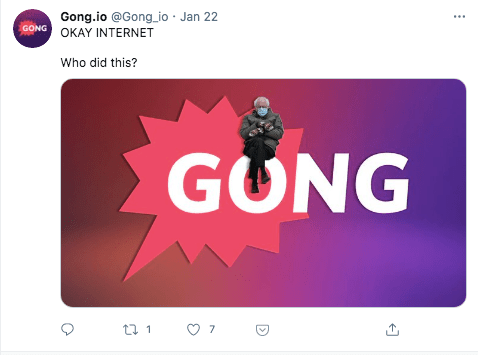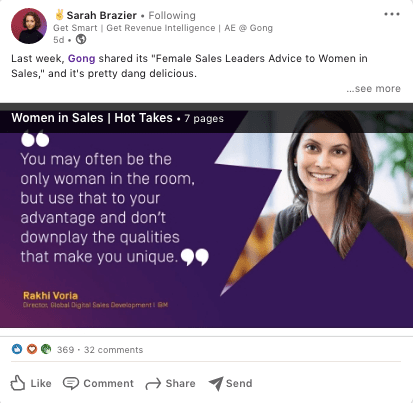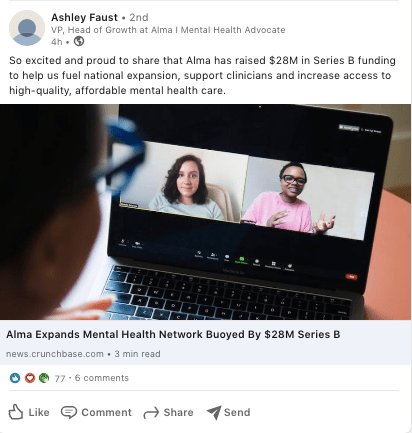Is your company already dabbling in some form of employee advocacy?
This could be internal newsletters with shareable content, a pilot program or consistent reminders to employees about sharing social content. Employees may even be asking for more content to share. Or, you see powerful performance indicators and you want to kick it up a notch.
You’ll notice that these efforts are effective—but not fully optimized. At some point, you’ll need a full-fledged employee advocacy program. But jumping to the next level is a daunting challenge.
How do you know when it’s time to scale?
6 Indicators You’re Ready To Invest More In Employee Advocacy
1. You’re already sending email newsletters
Internal emails are a great way to get started with employee advocacy. Emails can be used to reduce silos between departments, recognize high-performing employees, and distribute social content. Sometimes people don’t know exactly what to share on social media and it helps to have a little help from some friends.

(If your meme rockstars contribute to the email or group message, you’re especially on solid ground).
Katie Higgins and Julia Woodward from VTS shared how email newsletters was one of the key tools VTS that accelerated their employee advocacy efforts. Two weekly emails helped prompt employees to share engaging content. By increasing their email activity, they increased their overall share rate.
After considering ways to boost engagement among employees, you could consider a platform that helps make sharing social content frictionless and measurable.
If you have hundreds of employees sharing content from your internal newsletter, you’ll want to know what’s working. For example, which content performed best, which employees are most likely to share content and more. Without an employee advocacy platform, this isn’t easy to measure.
2. You’re running a successful pilot program
Most companies begin their employee advocacy efforts with a pilot program. A pilot program could look like the marketing team identifying the employee influencers within their organizations and encouraging them to start sharing on social media for the company more. Or it could include investing in official social media training and education.
When you’re running this pilot program, there are certain metrics you can measure to determine the success of the program. The most effective key performance indicators (KPIs) are those tied to overall company performance. The challenge is that, as you create and distribute more content, the more difficult it will be to tie outcomes to the pilot program.
If you see higher social media reach and engagement, more website traffic or other positive benefits from your pilot program then you’re ready to transition from bootstrapping analytics to a platform that can track KPIs more precisely.
Learn how Gainsight scaled their employee advocacy program to hundreds of employees after running a successful pilot program.
3. Your process right now is too tedious and manual
The challenge with a full-fledged employee advocacy program is that it requires intentional communication, coordination, and strategy. Not to mention a great deal of engaging content creation and promotion.
To organize this process, you might have several spreadsheets shared between team members, emails, Slack or Microsoft Teams messages, and social media management tools.
It’s also essential to measure the outcome of your efforts, which requires more UTM parameter tracking. Google Analytics will be a great place to start measuring your efforts, but unfortunately, it’s not easily scalable. If you want to reduce the number of spreadsheets you need to access, it’s time to invest in an employee advocacy platform.
4. You have a group of socially-engaged users
To build brand recognition and trust, you’ll have to engage with your ideal customers where they’re at. And it’s most likely that your customers and prospective buyers are already active on social media.
In fact, LinkedIn research found that 69% of buyers were more likely to choose a vendor if the salesperson is recommended to them by someone in their professional network.
If you’re seeing engagement with your organic efforts from employees, reinforcement from a scaled advocacy program will certainly drive brand awareness.
You can encourage active conversations around your company and employee stories across professional networks—but it does require coordination. If you want to see more engagement, it’s time to scale your employee advocacy program.
5. Your branded channels have a strong social presence
If your branded content is already strong, then a scaled employee advocacy program will only reinforce what you’ve established.
Gong, for example, has incredible branded content across LinkedIn, Youtube, Twitter, and Instagram.

But when its employees share content, engagement is significantly higher.

If you see traffic come from social, this is a strong indicator that employees can build on that momentum even further.
6. You’re creating a lot of great content
73% of B2B buyers say they typically consume between three and seven pieces of content before speaking with a salesperson, according to the Demand Gen 2019 Content Preferences Report. Educational and trustworthy content is the crux of a strong, scalable employee advocacy program.
You can encourage employees to share updates about your company. However, if they don’t know what to share, your efforts will likely fall flat. Instead, if you equip employees with the content that will drive engagement, you’re more likely to see success.
Content can include company updates, customer stories, blogs, videos, or upcoming events. But it’s even more effective when employees share why they’re personally excited about the update. It adds that personal touch and feels more real.

If you’re producing content but aren’t seeing results, explore a greater organized way for employees to share to their networks.
Uniting Teams on Your Company’s Mission and Content
Before scaling your employee advocacy efforts, be sure to unite teams and create content that people want to share.
“The idea of a single, shared purpose, mission, or goal is paramount to empowering a culture of content because it serves as the baseline of understanding. Establishing a common vision is a critical first step to developing a content strategy and is typically most effective when generated, embodied, and exemplified by leadership.”
It’s not just marketing and sales’ job to create and share interesting posts—everybody has a part to play. It’s just a matter of transitioning your fledgling employee advocacy efforts into a full-scale program.
For more information on how to scale your employee advocacy program, read our Employee Advocacy Guide.


